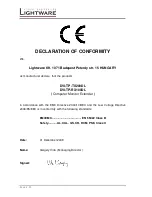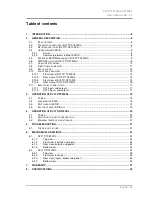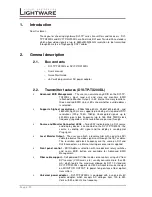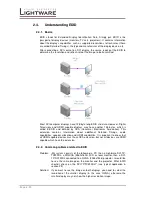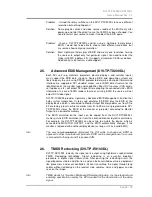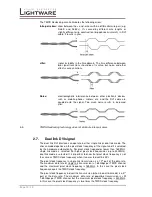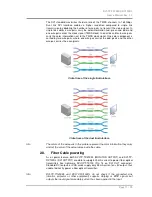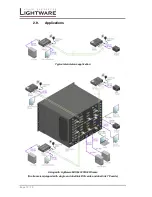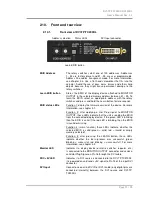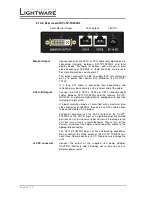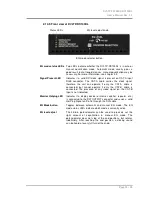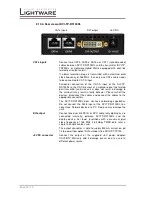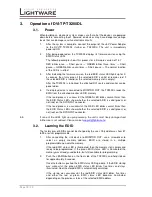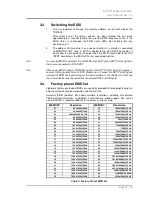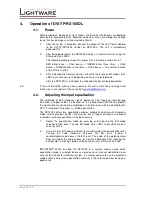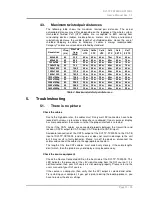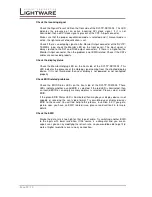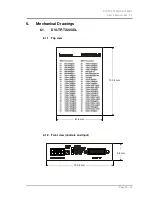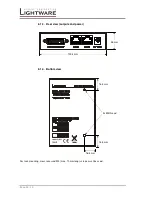
DVI-TP-TX200DL/RX100DL
User’s Manual Rev. 1.0
Page 9 / 29
Problem: „I turned the rotary switches on the DVI-TP-TX200DL to have a different
resolution but nothing happens.”
Solution: Some graphics cards and video sources read out the EDID only after
power-up and later they don’t sense that EDID has been changed. You
need to restart your source to make it read out the EDID again.
Problem: „I have a DVI-TP-TX200DL and I’m using a Lightware factory preset
EDID. I would like to be able to choose from different resolutions, but
my source allows only one resolution.”
Solution: Most Lightware factory preset EDID allow only one resolution, forcing
the sources to output only that particular signal. You need to select the
Universal EDID (address 49). It supports all common VESA resolutions.
Additionally it also features audio support.
2.5.
Advanced EDID Management (DVI-TP-TX200DL)
Each DVI sink (e.g. monitors, projectors, plasma displays, and switcher inputs)
must support the EDID data structure. Source BIOS and operating systems are
likely to query the sink using DDC2B protocol to determine what pixel formats and
interface are supported. DVI standard makes use of EDID data structure for the
identification of the monitor type and capabilities. Most DVI sources (VGA cards,
set top boxes, etc.) will output DVI signal after accepting the connected sink’s EDID
information. In case of EDID readout failure or missing EDID the source will not
output DVI video signal.
DVI-TP-TX200DL provides Lightware’s Advanced EDID Management function that
helps system integration. It stores and emulates 99 EDID plus the EDID of the
display device which is connected to Monitor Output. Memory addresses from 01 to
50 are factory presets, while memories from 51 to 99 are user programmable. DVI-
TP-TX200DL stores the EDID of the monitor or projector connected to Monitor
Output in a non-volatile memory.
The EDID emulated on the input can be copied from the DVI-TP-TX200DL's
memory (static EDID emulation) or from the attached monitor (dynamic emulation).
For example, the DVI-TP-TX200DL can be set up to emulate the device, which is
connected to MONITOR OUTPUT, and the EDID automatically changes if the
monitor is replaced with another display device (as long as it has a valid EDID).
Info
The user is not required to disconnect the DVI cable to change an EDID as
opposed to other manufacturer’s products. EDID can be changed even if a source
is connected to the input and it is powered ON.
2.6.
TMDS Reclocking (DVI-TP-RX100DL)
DVI-TP-RX100DL reclocks the signal on its output using Lightware’s sophisticated
TMDS Reclocking technology. Signal reclocking is an essential important
procedure in digital signal transmission. After passing the reclocking circuit, the
signal becomes stable and jitter-free, and can be transmitted over more equipment
like processors and event controllers. When transmitting the signal through long
cables without reclocking on the receiver side, sparkles, noise and jaggies can be
seen on the image.
Info
TMDS stands for Transition Minimized Differential Signaling. It is the electrical and
encoding specification used by the DVI standard for the transmission of the video
signal.
Содержание DVI-TP-RX100DL
Страница 1: ...DVI TP TX200DL DVI TP RX100DL User s Manual ...
Страница 2: ...Page 2 29 ...
Страница 29: ...DVI TP TX200DL RX100DL User s Manual Rev 1 0 Page 29 29 NOTES ...




